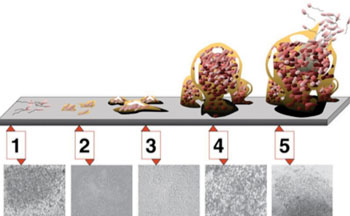Ionic Liquids Disperse Bacterial Biofilms and Increase Antibiotic Susceptibility
By LabMedica International staff writers
Posted on 16 Sep 2014
The ionic liquid choline-geranate was shown to effectively eliminate the protective biofilm generated by bacteria such as Salmonella enterica and Pseudomonas aeruginosa and to significantly increase the susceptibility of these microorganisms to antibiotic treatment.Posted on 16 Sep 2014
Biofilm-protected bacteria account for about 80% of bacterial infections in humans and are 50–1,000 times more resistant to antibiotics than bacteria that do not produce biofilms. Biofilms in skin are further protected by the outermost layer of skin, the stratum corneum, which serves as a natural barrier to most therapeutic agents.

Image: The five stages of biofilm development: (1) Initial attachment, (2) Irreversible attachment, (3) Maturation I, (4) Maturation II, and (5) Dispersion. Each stage of development in the diagram is paired with a photomicrograph of a developing P. aeruginosa biofilm. All photomicrographs are shown to same scale (Photo courtesy of Wikimedia Commons).
Following a search for agents capable of disrupting or inactivating biofilm protection, investigators at the Los Alamos National Laboratory (NM, USA) and colleagues at the University of California, Santa Barbara (USA) reported in the August 29, 2014, online edition of the journal Proceedings of the National Academy of Sciences of the United States of America (PNAS) on the use of ionic liquids (ILs) for biofilm disruption and enhanced antibiotic delivery across skin layers.
They outlined the syntheses of ILs and analyzed their relevant physicochemical properties and their subsequent neutralization effects on two biofilm-forming pathogens: P. aeruginosa and S. enterica. The ionic liquids were also examined for cytotoxicity, skin irritation, delivery of antibiotics through the skin, and treatment of biofilms in a wound model.
Of the materials examined, choline-geranate emerged as a multipurpose IL with excellent antimicrobial activity, minimal toxicity to epithelial cells as well as skin, and effective permeation enhancement for drug delivery. Specifically, choline-geranate was comparable with, or more effective than, bleach treatment against established biofilms of S. enterica and P. aeruginosa, respectively. In addition, choline-geranate increased delivery of cefadroxil, an antibiotic, by more than 16-fold into the deep tissue layers of the skin without inducing skin irritation. The in vivo efficacy of choline-geranate was validated using a biofilm-infected wound model (greater than 95% bacterial death after two hour treatment).
“In several cases, we found the ionic liquid was more efficacious on a biofilm than a standard bleach treatment and exhibited minimal cytotoxicity effects on human cell lines (unlike bleach),” said contributing author Dr. David Fox, a researcher at the Los Alamos National Laboratory. “This has excellent prospects for aiding antibiotic delivery to the pathogen through biofilm disruption but, most interestingly, the ionic liquids themselves are quite effective for pathogen neutralization. If the bacterial biofilm can be disrupted, delivery of antibiotics is greatly enhanced, and any dispersed pathogens are generally restored to normal antibiotic susceptibility. Further, many bacterial infestations in wounds penetrate under the outer skin layer, the stratum corneum, and deep into the tissue (epidermis and dermis). These materials are able to penetrate through the skin and effectively carry antibiotics to the deepest layers.”
Related Links:
Los Alamos National Laboratory
University of California, Santa Barbara














